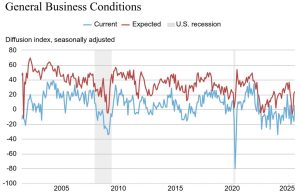Despite the signs of an improving economy, including the rising housing and stock markets and a slight decline in the nation’s unemployment in April, upstate New York consumers are remaining cautious with their wallets. Upstate New York’s consumer sentiment rose 2.2 points to 68 in April, according to the latest monthly survey from the Siena […]
Get Instant Access to This Article
Become a Central New York Business Journal subscriber and get immediate access to all of our subscriber-only content and much more.
- Critical Central New York business news and analysis updated daily.
- Immediate access to all subscriber-only content on our website.
- Get a year's worth of the Print Edition of The Central New York Business Journal.
- Special Feature Publications such as the Book of Lists and Revitalize Greater Binghamton, Mohawk Valley, and Syracuse Magazines
Click here to purchase a paywall bypass link for this article.
Despite the signs of an improving economy, including the rising housing and stock markets and a slight decline in the nation’s unemployment in April, upstate New York consumers are remaining cautious with their wallets.
Upstate New York’s consumer sentiment rose 2.2 points to 68 in April, according to the latest monthly survey from the Siena (College) Research Institute (SRI) released May 9.
Upstate’s overall-sentiment index of 68 is a combination of the current-sentiment and future-sentiment components. Upstate’s current-sentiment index of 73.9 climbed 2.3 points from March, while the future-sentiment level rose 2.2 points to 64.2, according to the SRI data.
The upstate figure was nearly six points below the statewide consumer-sentiment level of 73.9, which was down 0.6 points from March, SRI said.
New York’s consumer-sentiment index was 2.5 points lower than the figure for the entire nation of 76.4, which slipped two points from March, as measured by the University of Michigan’s consumer-sentiment index.
Nationally, the consumer-confidence measurement hasn’t “budged” in a year, and “it’s just getting frustrating,” says Douglas Lonnstrom, professor of statistics and finance at Siena College and SRI founding director.
“[At 76.4] it’s identical to where it was in April 2012, a year ago. Identical to the tenth of a point,” Lonnstrom says. Meanwhile, all three major stock indices — the Dow Jones Industrial Average, Nasdaq, and S&P 500 — are all up more than 15 percent in the last 12 months, he notes. The SRI news release reporting the survey results used the headline: “As Wall Street Soars, Consumer Sentiment Languishes.”
At 73.9, the overall-sentiment figure for New York is down about 0.7 points from April 2012, moving less than a point in a year, he notes.
A further breakdown indicates movement in the current and future components, but it also provides evidence for the lack of movement in the overall component, Lonnstrom says.
“[At 76.6] The current component is up about six points from a year ago [71.0], so people are feeling better right now than they were year ago about things today. That’s almost exactly offset by the future component [72.3], which is down five points [76.9 in April 2012]. That’s why the overall [component] stayed virtually flat,” Lonnstrom explained.
When compared with the previous three years, the state’s overall-confidence sentiment of 73.9 is down 0.7 points from April 2012, up 9 points from April 2011, and has increased 7.1 points compared to April 2010, according to the SRI data. The sentiment index measured 55 in April 2008.
Beyond the component readings, the nation’s housing market is starting to improve, unemployment data was better in April, and the stock market continues to soar, Lonnstrom says.
“Corporate earnings are doing well, and of course, part of that is because they haven’t hired a lot of people,” he says.
Once the nation’s biggest firms start feeling better about the future, they’ll hire more employees, Lonnstrom says, believing that will lead to higher consumer sentiment in New York and nationwide.
Besides determining consumer sentiment, SRI’s monthly survey also examines New York state respondents’ plans for buying big-ticket items in the next six months.
In April, buying plans rose 0.7 points to 5.2 percent for homes and increased 0.2 points to 16.6 percent for major-home improvements compared to March.
“Home buying plans were up sharply and crossed five percent for the first time since last spring and summer, anticipating not only increased housing sales but also leading to the economic activity including furniture purchases that accompany moving into a new home,” Lonnstrom said in the SRI news release.
Buying plans in the state fell 2.1 points to 11.8 percent for cars and trucks in April, decreased 0.3 points to 14.7 percent for computers, and slipped 0.4 points to 22.7 percent for furniture, according to the SRI data.
Gas and food prices
In SRI’s monthly analysis of gas and food prices, 68 percent of upstate respondents said the price of gas was having a serious impact on their monthly budgets, which is down from 74 percent in March and 70 percent in February.
In addition, 59 percent of statewide respondents indicated concern about the price of gas, down from 62 percent in March, according to SRI.
When asked about food prices, 72 percent of upstate respondents indicated their grocery bill was having a serious impact on their finances, down from 71 percent in March. About 70 percent of statewide respondents expressed concern about their food bills, up from 68 percent in March.
The same analysis also gauges the combined concern about food and gas prices. About 57 percent of upstate respondents are worried about the cost of both, down from 63 percent in March.
The analysis also found 50 percent of all New York respondents had concerns about the price of both food and gas, down from 51 percent in March.
SRI conducted its consumer-sentiment survey in April by random telephone calls to 805 New York residents over the age of 18.
As consumer sentiment is expressed as an index number developed after statistical calculations to a series of questions, “margin of error” does not apply, SRI says. Buying plans, which are shown as a percentage based on answers to specific questions, have a margin of error of plus or minus 3.5 points, according to SRI.
Contact Reinhardt at ereinhardt@cnybj.com



